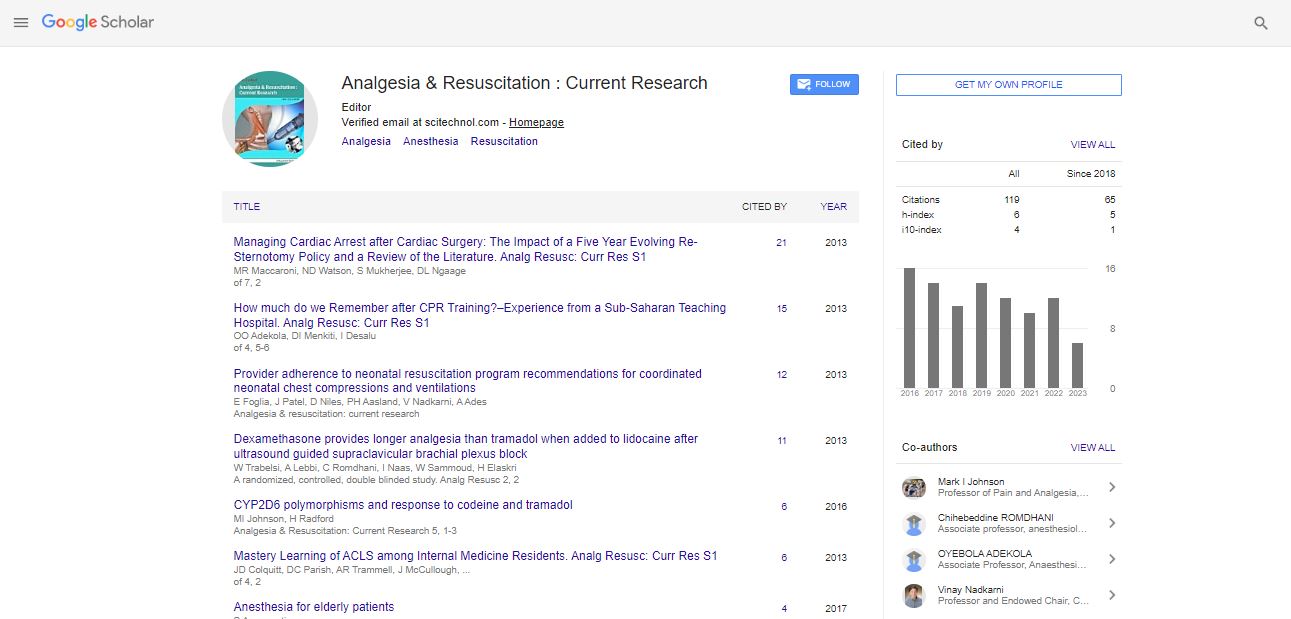The influence of BMI, gender and age on pain and medication usage after Facet - Medial Branch or SI Joint Lateral Branch Neurotomy (cooled RFSInergie) in Facetjoint or SI Joint mediated low back pain. A large case series of RF Treatment for low back pain (The Austrian Experience)
Wolfgang Stelzer
Medical Center Painless, Austria
: Analg Resusc: Curr Res
Abstract
Background: Facet joints and the sacroiliac joint (SIJ) complex have been identified as a common source of chronic low back pain. Low back pain is a common problem. The prevalence of facet joint (FJ) mediated low back pain is 31% i - 45%ii, the prevalence for the SI Joint as a source of chronic axial low back pain is reported between 18% and 30% iii. Radiofrequency (RF) neurotomy has been investigated in recent years as a minimally invasive treatment option for FJ –and SIJ-mediated low back pain. The use of a test block as a predictive factor is well documented. Predective co-factors like BMI, gender, and comorbidities for successful and long term pain decrease have not been well established. Objective: This retrospective study was designed to illustrate the general outcome after radio frequency neurotomy of lumbar medial branches and rami posterior of the SI Joint in patients with low back pain 1, 6 and 12 months after treatment. Outcomes were stratified by BMI, gender and age to determine their effect on the reduction of opioids and NSAIDS. Study Design: The records of 164 patients with chronic low back pain who underwent treatment with RF medical branch Neurotomy (parallel needle technique) and/or cooled RF LBN in case of SI Joint mediated low back pain were identified. Subjects were selected for treatment based on physical examination and positive response (>50% pain relief) to a lumbar medial branch block/Ramus dorsalis L5 block or intra articular SIJ block. Lumbar medial branches L3 and L4 and the ramus dorsalis L5 were lesioned in „ISIS“parallel needle technique (N=36), Cooled RF LBN involved lesioning the L5 dorsal ramus and lateral to the S1, S2, and S3 posterior sacral foraminal apertures (N=87). Visual analog scale (VAS) pain scores, quality of life, BMI, medication usage, and satisfaction were asked before the procedure, at 1 month post procedure (N = 164), and again after 6 (N= 75) and 12 months (N=89) post procedure. Results: A VAS decrease in the total group was seen from 8 to 4 after 6 months and 4.5 after 12 months, and lower medication usage (opioids decreased 40%, NSAIDS decreased 60%). Pain decrease can be shown in this study for 12 months. Our data illustrate a significant better outcome for patients with a BMI lower than 30. There is no difference in VAS decrease between male and female. There were no severe or moderate complications during or after all procedures. Conclusion: The data may suggest the use of RF treatment in case of low back pain as a proper treatment option as well as the probability of 95% to have a VAS decrease of 3-4 points on a 0-10 scale. Treatment of chronic low back pain with RF modalities is a safe, long term effective, pain reducing treatment option. Public insurance should be encouraged to provide reimbursement for this safe and reliable method of treating low back pain.
Biography
Wolfgang Stelzer founded a medical centre for pain management and outpatient surgery center in 2004 (called “Zentrum SchmerzLOS” that’s a german word for pain free and for the fate of pain patients synonymious). Since that time he could establish the pain centre in a large part of Austria as a centre for interventional pain therapy in Vienna with the centre in Baden/Vienna and Upper Austria with the centre in Linz. Currently we are a team of 16 ambitious doctors and nurses specialized for anaesthesia and pain therapy and we treat about 3500 patients a year. Our treatment with fluoroscopy guided interventions is strictly following the ISIS guidelines. Large priority of SchmerzLOS is set on scientific research, on the one hand for quality improvement, on the other hand for improvement of interventional pain therapy
 Spanish
Spanish  Chinese
Chinese  Russian
Russian  German
German  French
French  Japanese
Japanese  Portuguese
Portuguese  Hindi
Hindi 
